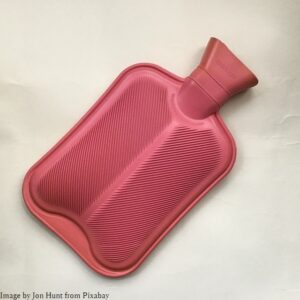 Dysmenorrhea refers to lower abdominal pain felt during menstruation. It is divided into two broad categories, which are primary and secondary dysmenorrhoea.
Dysmenorrhea refers to lower abdominal pain felt during menstruation. It is divided into two broad categories, which are primary and secondary dysmenorrhoea.
- Primary dysmenorrhea refers to the presence of pain during menses without any obvious gynaecological disease that could account for these symptoms. The pain is typically recurrent, crampy pain that starts just before or with the onset of menses and then gradually reduces over the next 24 to 72 hours. It is more often seen in adolescents and young females. Physical examination and an ultrasound scan of the pelvis is usually normal.
- Secondary dysmenorrhea refers to the pain before and/or during menstruation in females with a gynaecological disease that could explain the symptoms. These could be endometriosis, adenomyosis, or uterine fibroids. The cramping pain can be in the lower abdomen, lower back or radiates to the inner thighs. The pain may even persist after menstruation has stopped.
It is a common problem, with 50 to 90 % of reproductive-age women experiencing monthly painful menses. The severity of symptoms varies greatly from woman to woman and may change over time in the same woman. Most of them are young adolescents with primary dysmenorrhea. Primary dysmenorrhea will improve with age in many women and less severe after a woman has had a baby. For secondary dysmenorrhoea, the severity will worsen over time if untreated.
Symptoms and signs
 Besides the pain symptoms, there may be associated symptoms such as nausea and vomiting, diarrhoea, sweating, lack of energy, urinary frequency, irritability, nervousness and depression. However, these are not so common.
Besides the pain symptoms, there may be associated symptoms such as nausea and vomiting, diarrhoea, sweating, lack of energy, urinary frequency, irritability, nervousness and depression. However, these are not so common.
Causes
The pain is due to the strong or prolonged contractions of the muscular wall of the uterus. This is usually caused by the increased concentration of certain prostaglandins, which is a type of chemical found in the cervix and uterus. Women with dysmenorrhea tend to have more of certain types of prostaglandins than those who don’t have as much discomfort. Other causes include:
- endometriosis with or without endometriotic cyst
- adenomyosis
- fibroids (especially those that are in the uterine cavity – called submucous type)
- congenital uterine or vaginal abnormalities.
- use of intrauterine device (IUD).
- pelvic infections.
Risk Factors
- it is similar to those risk factors for developing endometriosis, fibroids or adenomyosis
- smoking
- stress; lack of exercise; poor diet
- family history of dysmenorrhea.
- risk reduction is associated with younger age at first pregnancy, higher parity, and use of hormonal contraceptives.
Investigations

Clinical history and examination may help suggest the cause of dysmenorrhea. The first line of investigation is usually an ultrasound scan of the pelvic area. This can be done in the gynaecologist’s clinic. A blood test is usually not required unless there is associated heavy menstrual bleeding and it is done to exclude a low haemoglobin. Imaging studies such as Magnetic Resonance Imaging (MRI) is not routinely done to look for the cause. It is only reserved for very few instances when the cause cannot be identified after an ultrasound scan of the pelvis or when there is a poor response to treatment. Laparoscopy is not indicated unless the ultrasound scan of the pelvis showed a pathology that requires treatment with surgery.
Prevention
The use of combined oral contraceptive pills is effective in treating dysmenorrhoea and can help reduce the future risk of developing conditions that cause dysmenorrhoea. Other progestogen hormonal pills, injectables or implants that are often used for family planning have similar effects and benefits.
Treatment of the underlying cause (with or without surgery) and the use of medications to prevent the recurrence.
Possible complications
- the presence of severe monthly pain can affect the quality of life, leading to school absenteeism, poor work performance and poor social life.
- infertility from the underlying cause
Treatment
- this will depend on the findings from the history, clinical examination, and ultrasound scan of the pelvis. Initial treatment aims to relieve the pain.

- In those with secondary dysmenorrhoea, the long-term goals of treatment involve treating any underlying cause with medication, or possibly surgery.
- heat can help relieve pain. Use a heating pad or hot water bottle on the abdomen or back.
- transcutaneous electrical nerve stimulator (TENS) treatment may help relieve pain.
- try to stop smoking and decrease alcohol use. Avoidance of caffeine may be beneficial.
 Medication
Medication
- for minor discomfort, use nonsteroidal anti-inflammatory drugs (NSAIDs) such as ibuprofen, naproxen, mefenamic acid or diclofenac. Other painkillers such as celecoxib or etoricoxib can be taken for relief. Start taking them as soon as pain symptoms begin until you feel better. If painkillers are taken early, is more effective. One should always keep to the recommended dosage and timing. Starting the medication when the pain is already severe or at maximal level is usually less effective. Other medications that may be prescribed are:
- combined oral contraceptive (COC) pills, which prevent ovulation.
- progestogens hormone (can be given as oral pills, injectables or implants) to reduce or stop menstruation.
- in severe cases, hormonal injections can be given to stop ovary function and relieve pain.
- use of the Intrauterine system (MIRENA) – this is an intrauterine device that releases a small dose of progestogen and is effective in reducing a significant amount of menstrual flow and dysmenorrhoea. It can last up to 5 years.
There are many alternative treatments available such as acupuncture, acupressure, yoga, relaxation or meditation sessions. These are generally not routinely recommended but you can try these and may find it useful.
Surgery may be recommended for women whose pain cannot be controlled by medications or when there is a cause of dysmenorrhoea. Various other treatment modalities such as uterine artery embolization (UAE), high-intensity focused ultrasound (HIFU) and radiofrequency ablation are not specific for the treatment of dysmenorrhoea. These treatment modalities are indicated only for certain gynaecological conditions.
Activity
- no restrictions.
- regular exercises can help reduce discomfort or pain during menses.

Expected Outcome
- dysmenorrhoea can be effectively controlled with treatment.
- in those with primary dysmenorrhoea, symptoms improve with age and with childbirth.
- in secondary dysmenorrhoea, improvement can be seen with medications, with or without surgery.
Consult your doctor if you develop the following symptoms:
- the dysmenorrhea that is increasing in severity despite taking the medication.
- menstrual bleeding that has become excessive (soaking a pad or tampon more frequently than once every 1 to 2 hours).
- new, unexplained symptoms develop. Drugs used in treatment may produce side effects.
To print a pdf copy click HERE

[mailerlite_form form_id=3]


 Medication
Medication